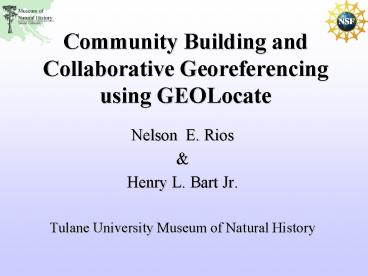Community Building and Collaborative Georeferencing using GEOLocate - PowerPoint PPT Presentation
1 / 40
Title:
Community Building and Collaborative Georeferencing using GEOLocate
Description:
As applied to natural history collection data it is the process of assigning ... Similar records from various institutions can be flagged and georeferenced at once ... – PowerPoint PPT presentation
Number of Views:40
Avg rating:3.0/5.0
Title: Community Building and Collaborative Georeferencing using GEOLocate
1
Community Building and Collaborative
Georeferencing using GEOLocate
- Nelson E. Rios
- Henry L. Bart Jr.
- Tulane University Museum of Natural History
2
What is Georeferencing
- As applied to natural history collection data it
is the process of assigning geographic
coordinates to a textually described collecting
event - Traditional approaches laborious and time
consuming - Automated and collaborative processes have proven
to improve efficiency
3
GEOLocate Overview
Desktop application for automated georeferencing
of natural history collections data
Initial release in 2002
Locality description analysis, coordinate
generation, batch processing, geographic
visualization, data correction and error
determination
4
Overview Locality Visualization Adjustment
Computed coordinates are displayed on digital maps
Manual verification of each record
Drag and drop correction of records
5
OverviewMultiple Result Handling
Caused by duplicate names, multiple names
multiple displacements
Results are ranked and most accurate result is
recorded and used as primary result
All results are recorded and displayed as red
arrows
Working on using specimen data to limit spread of
results
6
OverviewEstimating Error
User-defined maximum extent described as a
polygon that a given locality description can
represent
Recorded as a comma delimited array of vertices
using latitude and longitude
7
Current Lines of Development
- Taxonomic Footprints
- Collaborative georeferencing
- Global expansion
- Multilingual georeferencing with user-defined
locality grammar
8
Taxonomic Footprint Validation
Uses point occurrence data from distributed
museum databases to validate georeferenced data
Taxa collected for a given locality
Species A
Species B
9
Footprint for specimens collected at Little
Schultz Creek, off Co. Rd. 26 (Schultz Spring
Road), approx. 5 mi N of Centreville Bibb
County White circles indicate results from
automated georeferencing. Black circle indicates
actual collection locality based on GPS. This
sample was conducted using data from UAIC TUMNH
10
Collaborative Georeferencing
- Distributed community effort increases efficiency
- Web based portal used to manage each community
- DiGIR used for data input (alternatives in
development) - Similar records from various institutions can be
flagged and georeferenced at once - Data returned to individual institutions via
portal download as a comma delimited file
11
Collaborative Georeferencing
12
(No Transcript)
13
(No Transcript)
14
(No Transcript)
15
(No Transcript)
16
(No Transcript)
17
(No Transcript)
18
(No Transcript)
19
(No Transcript)
20
(No Transcript)
21
(No Transcript)
22
(No Transcript)
23
(No Transcript)
24
(No Transcript)
25
(No Transcript)
26
(No Transcript)
27
(No Transcript)
28
(No Transcript)
29
(No Transcript)
30
(No Transcript)
31
(No Transcript)
32
(No Transcript)
33
(No Transcript)
34
Global Georeferencing
- Typically 11,000,000
- Will work with users to improve resolution
(examples Australia250K Spain200K) - Advanced features such as waterbody matching
bridge crossing detection possible but requires
extensive data compilation (example Spain)
35
Multilingual Georeferencing
- Extensible architecture for adding languages via
language libraries - Language libraries are text files that define
various locality types in a given language - Current support for
- Spanish
- Basque
- Catalan
- Galician
- May also be used to define custom locality types
in English
36
(No Transcript)
37
(No Transcript)
38
Future Directions
- Collaboration with foreign participants to
improve datasets and language libraries - Cross platform Java client
- More web services integration
- Integration of WFS WMS for mapping
- Alternatives to DiGIR
39
Final Thoughts
- Approximately 20 of DiGIR providers (excluding
fish collections) tested have problems of
stability and/or data quality resulting in the
inability to cache records. - Typical data quality issues
- Malformed data (common in datelastmodified)
- Catalog numbers missing and/or duplicated
- Resolution requires dedicated infrastructure for
data providers or alternative means of serving
data.
40
Acknowledgements
- Djihbrihou Abibou
- Andy Bentley
- Shwetha Belame
- Paul Flemons
- Demin Hu
- Sophie Hung
- John Johanson
- David Draper Munt
- Dave Vieglais
- Ed Wiley
- National Science Foundation































